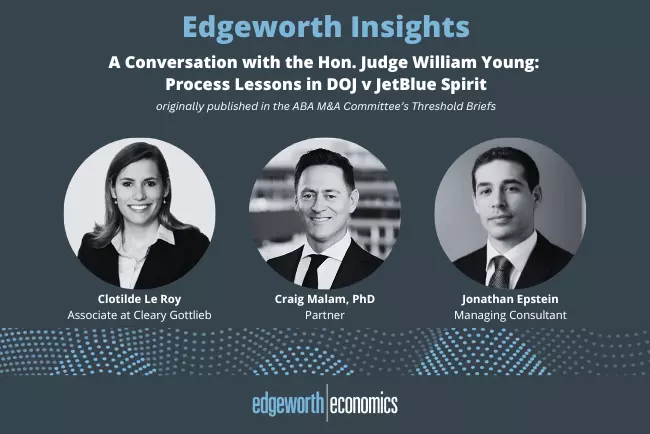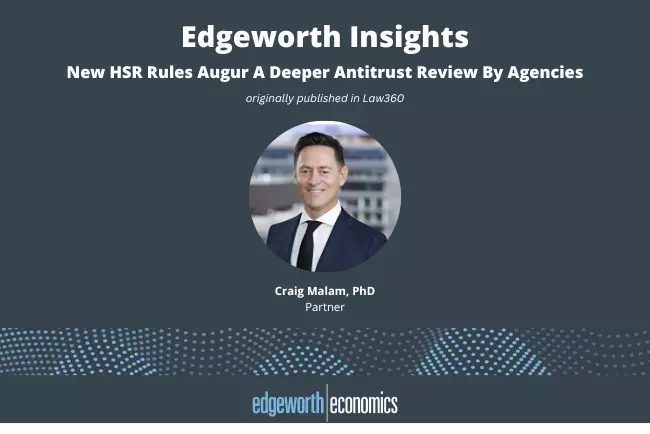Edgeworth Insights Archive
- 04.25.2024
The American Bar Association Labor and Employment Section held its annual Equal Employment Opportunity Law Conference in Boston from March 19 to March 22, 2024. Over 200 attendees took part in the four-day conference.
- Blog, 04.19.2024
We have developed a tool that provides a preview of the prevailing wages that the OFLC will officially announce on July 1, 2024. Our interactive tool focuses on 34 occupations that account for a majority of H-2B visas in over 3,000 combinations of states and counties.
- Blog, Bloomberg Law | 04.12.2024
Mike Kheyfets compiled a unique database of over 100 BIPA settlements and studied the evolution of damages issues BIPA litigation cases. The research, including a look ahead to what the findings may mean for the future, were published today in Bloomberg Law.
- Blog, Law360 | 03.11.2024
Sushrut Jain and Valentina Bernasconi discuss damages estimation in class action suits with allegations of excess "slack-fill" in the packaging of consumer goods.
- Blog, 02.20.2024
Our research into settlements in data breach class actions suggests that settlements in these matters may be less informative for assessing the value of a case as whole, as well as the value of the data exposed in the cyberattack.
- Blog, 02.08.2024
Over 130 countries – including some that are reputed tax havens – have, in recent years, moved to align their tax policies. Consequently, Multinational Enterprises (MNEs) will sustain a higher tax floor as countries adapt a global minimum corporate tax rate (GMT), and bear more oversight as standardized transfer pricing methods are instituted.
- Blog, 01.11.2024
Federal anti-discrimination laws in the U.S. protect applicants, employees, and former employees from employment discrimination based on race, color, religion, sex, national origin, age, disability, and genetic information. One dimension not included is discrimination based on an individual’s “caste.”
- Blog, 12.18.2023
Farmers and ranchers who hire seasonal workers on H-2A visas will face prevailing wages in 2024 that are about 5.54% higher, on average, than in 2023. This occurs after a large increase in H-2A wages between 2022 and 2023. The H-2A visa program requires that visa workers, and domestic workers in corresponding employment, are paid at least the prevailing wage, or Adverse Effect Wage Rate (AEWR). AEWRs are determined by the US Department of Labor (DOL) and vary by region. AEWRs will increase in every region between 2023 and 2024 with the largest increases in Hawaii (8.64%), Alabama, Georgia, and South Carolina (7.39%), and Oregon and Washington (7.12%).
- Blog, ABA Antitrust Law Section Newsletter | 12.04.2023
On November 9, 2023, the American Bar Association Antitrust Law Section held its annual Fall Forum focused on the theme “Can Antitrust and Consumer Protection Keep Up with Artificial Intelligence (AI)?” This exciting program brought together computer scientists performing cutting-edge AI research, policymakers considering proper legislation for regulating these new technologies, and practitioners navigating the implications of this changing legal landscape in the scope of antitrust, privacy, and consumer protection.
- Blog, 10.31.2023
The NPRM claims the new salary threshold for the EAP exemption “will, in combination with the standard duties test, better define and delimit which employees are employed in a bona fide EAP capacity in a one-test system.” However, the new salary threshold is set at the 35th percentile of the non-hourly pay distribution in the South region, which is $1,059 per week. The non-hourly pay distribution includes many blue-collar workers and white-collar workers explicitly excluded from the FLSA (such as teachers), raising doubts as to whether an arbitrary threshold from this distribution has any ability to determine which EAP employees are bona fide.
- Blog, 10.30.2023
The Department of Labor’s (DOL’s) NPRM provides estimates of the number of employees affected by the proposed salary test level increases, but projections are only as good as the data on which they are based. In fact, there is no data currently collected that would enable an accurate and reliable estimate of the number of employees who are subject to the FLSA or how many employees are classified as exempt, much less an estimate of those that would be impacted by the proposed changes.
- Blog, 10.27.2023
The NPRM touts that an estimated 3.4 million employees will “gain overtime protection” under the proposed regulations. As described in our post on October 25, it is unlikely that the new rule will increase compensation of the re-classified employees.
- Blog, 10.25.2023
The Department of Labor claims that the increased salary test level will “give employees higher earnings in the form of transfers of income from employers to employees,” but that assertion is inconsistent with economic reasoning. Even the economic studies cited in the NPRM cast doubt on that assumption.
- Blog, 10.23.2023
On September 8, 2023, a Notice of Proposed Rule Making (NPRM) from the Department of Labor was published in the Federal Register titled “Defining and Delimiting the Exemptions for Executive, Administrative, Professional, Outside Sales, and Computer Employees.”
- Blog, 10.23.2023
The Department of Labor’s Notice of Proposed Rulemaking (NPRM) regarding the white-collar exemption to the Fair Labor Standards Act (FLSA) includes an initial regulatory flexibility analysis that is required for all regulations that will have a material impact on small businesses. In that analysis, the Department concludes that 1.3 million workers employed by between 179,700 and 1.3 million small businesses will be impacted by the substantial increase in the white-collar exemption salary threshold in the NPRM. However, that analysis almost certainly understates the impact on small businesses.
- Blog, 10.11.2023
Artificial intelligence (“AI”) has long been a hot topic across various industries, including the legal sector, especially with the recent breakthrough of innovative generative AI system—Large Language Model (“LLM”) applications like ChatGPT that can process and generate humanlike text in real-time. These technologies can revolutionize the way legal cases are managed, making it more critical than ever for professionals in the legal industry to learn how to harness the power of generative AI to their advantage—and to understand the limits of its capabilities.
- Blog, 10.05.2023
U.S. District Judge Barbara Lynn's decision in Federal Trade Commission v. Neora LLC in the U.S. District Court for the Northern District of Texas last week marks a landmark victory for the direct selling industry.[1]
- Blog, 09.07.2023
Employers may not be paying attention to BIPA and resulting litigation in Illinois, but they should. BIPA class action lawsuits have surged since 2015, and filings are expected to reach new heights by the end 2023 [1]. Similar proposals, often modeled after BIPA, have emerged in Arizona, Hawaii, Maryland, Massachusetts, Minnesota, Mississippi, Missouri, New York, Tennessee, Vermont, and Washington, and others are likely to follow [2] [3].
- Blog, 08.08.2023
Biotechnology companies Natera and CareDx have been engaged in a prolonged legal battle regarding the validity of patents covering methods of cell-free DNA analysis for noninvasive monitoring of organ transplant rejection. The case has been lauded by the legal community as the “last chance for diagnostic patents” to be reviewed by the Supreme Court.[1]
- Blog, 06.06.2023
When tasked to quantify potential pay gaps between gender or race groups, economists usually rely on multivariate regression analysis. In pay equity studies, this regression estimates the average pay difference between male and female employees after accounting for important factors which affect pay. However, if any of those factors (known as control variables) are measured with error, pay differences might erroneously be attributed to gender and biased results can emerge.
- Blog, 04.27.2023
Dr. Stephen Bronars, Edgeworth Economics Partner, analyzes the anticipated new salary thresholds for the Fair Labor Standards Act, expected to be proposed in May.
- Blog, 04.04.2023
On March 1, 2023, the House Committee on Oversight and Accountability launched an investigation into alleged anticompetitive behavior by pharmacy benefit managers (PBMs). Committee Chairman James Comer requested information from government agencies and three of the largest PBMs, citing concerns that consolidation among PBMs has “forced manufacturers to raise their prices” and led to “increased costs for consumers.”
- Blog, 03.07.2023
Dr. Stephen Bronars of Edgeworth Economics analyzes the Federal Trade Commission’s stance that non-compete clauses reduce worker earnings across industries, saying that research doesn’t support this conclusion.
- Blog, 02.07.2023
In July 2021, the White House ordered the Consumer Financial Protection Bureau (CFPB) to promote competition in consumer financial markets through enforcement actions or rule-making. As a result, the CFPB is now poised to begin regulating and enhancing competition in consumer finance.
- Blog, 01.10.2023
One of the most relied upon statistical tools implemented by economists is regression analysis, a method with which to study the relationship between a variable of interest and “additional explanatory variables that are thought to produce or be associated with changes in the variable of interest.” Regression analysis can be particularly useful in the context of antitrust litigation.
- Blog, 12.06.2022
The relevant economic issues in antitrust class action cases that involve indirect purchasers— class members who did not purchase the product at issue directly from one of the defendants, but instead from another seller further down the supply chain—are often complex and idiosyncratic to each specific industry.
- Blog, 12.02.2022
Farmers and ranchers who hire foreign-born seasonal workers on H-2A visas will face prevailing wages in 2023 that are about 9.36% higher, on average, than the prevailing wages for H-2A workers in 2022.
- Blog, 11.01.2022
Edgeworth Economics President Chuck Fields and Principal Consultant Dr. Stephanie Cheng recently presented on this topic at the DC SHRM 2022 Annual Conference. This post summarizes their key takeaways from that event.
- Blog, 10.04.2022
Regression analysis is a statistical tool used by economists, statisticians, and others to “understand the relationship between or among two or more variables.” Any attorney new to the antitrust space will invariably encounter regression analysis frequently. In this article, we provide a brief introduction to the regression methodology.
- Blog, 09.06.2022
When pharmaceutical manufacturers develop a new branded drug to take to market, they are granted a period of exclusivity via patent to help recoup the massive costs of research and development. Upon expiration of this patent, generic manufacturers can enter the market with therapeutically equivalent products and compete with the brand.
- Blog, 08.02.2022
Over the past six months, airfares have increased at a breakneck pace. The consumer price index for airline tickets increased by 63% from November 2021 to May 2022, the largest increase over a 6-month period by far since the index was created in 1989 by the Federal Reserve of St. Louis.
- Blog, 06.27.2022
Federal and state labor laws limit which employees can legally be paid a salary independent of hours worked. The Fair Labor Standards Act (FLSA) is the Federal law requiring that certain workers receive overtime compensation, at 1.5 times their regular rate of pay, for all hours of work above 40 each week.
- Blog, 06.07.2022
On March 7th, the Treasury Department released a draft report entitled “The State of Labor Market Competition” (herein “the report” or “the Treasury”), which addressed the level of concentration and anti-competitive labor practices in the U.S. economy. The report claimed to reaffirm the current administration’s executive orders regarding promoting competition in labor markets and examines possible implications.
- Blog, 03.01.2022
We gathered our Labor and Employment experts together and asked them: What is the “Great Resignation,” and what does it mean for employers?
Excerpts of their wide-ranging conversation were lightly edited for clarity and reported here. - Blog, 02.01.2022
Economic experts often employ two approaches that use public settlement information to estimate potential exposure for a client- a top-down approach or a bottom-up approach.


